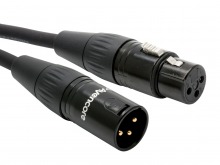


Let's break down Avencore's Pro Audio cable offering here and see what we get...
We'll start at the core of this 50cm cable. There you'll find 2x 24 AWG carriers, each with 20 strands of 0.12mm Oxygen Free Copper (OFC). Surrounding these are an additional five layers of materials:

Joined at each end we have some very well made connectors. All Avencore XLR cables feature high quality Yongsheng connectors for maximum long term reliability and signal quality. Genuine Yongsheng connectors have superior contact points, higher quality components and tighter tolerances when compared to inferior products and counterfeits. The pins on all Avencore XLR connectors (male and female) are also gold plated for long term, high quality conductivity.
Avencore Platinum Series 50cm XLR Cable Specs:
- Avencore 5 Year Warranty
- Well made and thought out, reliable, professional level cables
- Genuine high quality Yongsheng XLR connectors with gold plated pins
- 24 Gauge OFC Carriers (20 x 0.12mm strands per carrier)
- PE Isolation
- Conductive PVC insulation
- Tin Annelled Copper Wire Braided Shield
- Wiring:
Pin 1, Ground (wired to shield)
Pin 2, Positive (red)
Pin 3, Negative (black)
- Comes with a reusable soft cable tie to aid with storage.
- Black cable with black connectors for inconspicuous use
Balanced microphone cables, a brief explanation.
Microphones operate on a very low voltage, this means the signal traveling from the microphone to the sound desk/audio interface can very easily pick up unwanted interference along the way. When this low voltage signal is received and amplified to desirable listening levels any unwanted interference picked up along the way is also amplified to not so desirable listening levels.
To get around this, microphone cables can be balanced. This involves sending the signal from the microphone along two carriers instead of one. The first carrier is the normal signal heard by the microphone but the second one is inverted (put out of phase). Both carriers pick up the same interference from various sources (mobile phones, power cables etc.) along the way. When the two signals arrive at their destination the second signal is re-inverted back into normal phase to match the first signal again. When this happens, the interference, which is now out-of-phase between carrier one and carrier two is cancelled out and cannot be heard any more. Clever!
